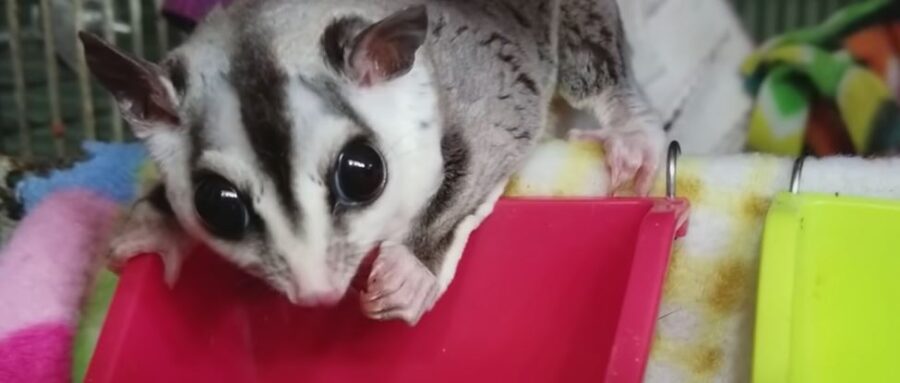Do you think your sugar glider is skinny? Are you sure they are unwell or would you like a second opinion?
Why is my sugar glider so skinny when I feed him well? Did I go something wrong? I researched and found some solutions.
Overall, this article and a check up from the vet may help your skinny sugar glider.
Why Is My Sugar Glider So Skinny?
Malnutrition is the leading cause of sugar gliders becoming skinny. Focus not only on the food quality, but also remove stress factors that may cause your sugar glider to abstain from meals.
Hypoproteinemia is when there is a lack of dietary protein to build muscle and sustain weight. Anemia is when too few red blood cells are created causing weight loss in sugar gliders.
Liver and kidney problems may result after a long period of time where sugar gliders do not get enough nutrition.
If your sugar glider is showing the following symptoms below, keep reading on and see if we can help. Otherwise, seek a veterinarians’ help to come up with a plan that is unique to your pocket pet.
- weak
- responds slowly
- dehydrated

Does My Sugar Glider Have MBD?
If you suspect that your sugar has a calcium deficiency or metabolic bone disease (MBD) you might be seeing the following signs:
- Lethargy
- Lameness
- Paralysis
- Moving gingerly or with pain
Sugar gliders can take calcium supplements to increase their consumption and maintain strong bones while in captivity.
Calcium may not be absorbed as well and constipation may happen if extra fiber-rich roughage isn’t added.
What Is the Normal Weight of a Sugar Glider?
A sugar glider is not supposed to be heavy. They weight about:
- 100-160 grams for males
- 80-130 grams for females
On average the body weight of sugar gliders is about 3-5 ounces for females and 4-6 ounces for males.
A reliable way to understand whether your sugar glider is overweight is to get them checked up regularly and weighed properly.
What Does a Healthy Sugar Glider Look Like?
If your guar glider seems skinny, but there are acting healthy, you might not have a great cause for concern, Check for the following signs that your sugar glider is healthy:
- alert
- clear eyes
- no discharge from nose
- no discoloration around mouth
- smooth and soft coat
Do not confuse the bald spots around the scent glands of male sugar gliders as a problem with their hair loss on their coats. This is normal and expected.

How Much Should a Sugar Glider Eat a Day?
How much should you feed a sugar glider? Sugar gliders need to consume between 15-20% of their body weight on a daily basis, which may not seem like a lot given that they only weigh between 3-6 ounces.
This amounts to around a teaspoon of nutritious pellets and two to three tablespoons of various fresh fruits and vegetables each day.
Why Is My Sugar Glider Vomiting?
Sugar gliders can have occasional vomiting, gastrointestinal cramping, loss of weight, and dehydration as a result of microscopic parasites such as:
- Cryptosporidium
- Giardia
- Trichomonas
- These parasites can also induce diarrhea.
The reason for these symptoms can be investigated by your veterinarian, who will then recommend treatment based on the results.
Because several of these parasites can also infect humans, it is important to exercise caution when handling sick sugar gliders and to wash your hands thoroughly after cleaning the cage as well as before touching any food or any item that will be near your mouth.
In addition to this, the cage should be meticulously cleaned in order to lessen the likelihood of re-infection.
Why Is My Sugar Glider Fat?
It is simple to overlook how little sugar gliders are in comparison to people. For a little sugar glider body, one nut may seem insignificant to humans but might contain a significant number of calories.
- Commercially produced sugar glider feed is beneficial, but I do not advise giving a diet that is exclusively composed of formulated feed. Instead, a daily diet should consist of a mix of fresh, healthy foods.
- Gliders don’t require snacks to eat. The majority of their waking hours are spent searching for food, hopping from branch to branch, and avoiding predators by wild sugar gliders.
- Sugar gliders raised as pets in comfortable cages with easy access to food do not maintain the same level of fitness and activity as their wild counterparts.

How To Help Sugar Gliders Gain Weight
Provide calorie-rich foods in moderation. Without a doubt, your glider won’t starve to death, and eventually they’ll get hungry enough to consume better foods.
Foods with a higher calorie count include:
- Crickets
- Nuts: (For a sugar glider, one nut is a substantial serving)
- Carrots
- Hard-boiled eggs
- Dubia Roaches
Remember that they only require between 10-20% of their body weight in food each day and do not overfeed.
Conclusion
A skinny sugar glider with healthy eyes, soft and shiny coat and no discoloration is just a bit smaller than their average sized counterparts in the wild island in captivity.
A vet will determine if your sugar glider is unhealthy or malnourished. We hope some of the tips in this article help you assess the overall condition of your pocket pet and let you decide the next course of action based on their eating, physical and behavioral habits.
Thank you for visiting PocketPetCentral.com for the best information to help you enjoy the life of your pocket pet companion in a fun, safe & healthy way.


